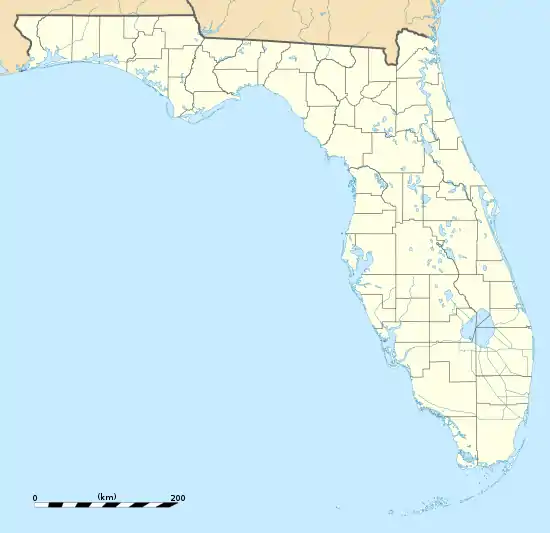Devil's Millhopper Geological State Park
Devil's Millhopper Geological State Park is a Florida State Park located in the north-westernmost part of Gainesville, Florida, off County Road 232, also known as NW 53rd Avenue and Millhopper Road, northwest of the University of Florida.
| Devil's Millhopper Geological State Park | |
|---|---|
IUCN category III (natural monument or feature) | |
 Boardwalk leading down to the sinkhole's observation deck | |
 | |
| Location | Alachua County, Florida, USA |
| Nearest city | Gainesville, Florida |
| Coordinates | 29°42′25″N 82°23′42″W |
| Area | 67 acres (27 ha) |
| Established | 1974 |
| Governing body | Florida Department of Environmental Protection |
| Designated | December 1974 |
The park is maintained by the Florida State Parks system, a division of the Florida Department of Environmental Protection. The park is adjacent to San Felasco County Park and is near the San Felasco Hammock Preserve State Park.
Geology
The most prominent feature of State Park is the large sinkhole formed by the dissolution of limestone by acidic groundwater over long periods of time.[1] Devil's Millhopper is unique in Florida in terms of its scale; over 100 feet of rock layers are exposed.[2]
The cutaway, limestone sides of the sinkhole provide an easily visible geological record of the area. Twelve springs, some more visible than others, feed the pond at the bottom of the sinkhole. In the summer, the bottom of the sinkhole is dramatically cooler than the air at the surface due to the depth and shade from the canopy above. Significant fossil deposits include shark teeth, marine shells, and the fossilized remains of extinct land animals.[2]
Ecology
Even though the park is only 71 acres (29 ha), three distinct ecological environments exist in the park, based on exposure to sun, fire, and water. In the sandhill environment, the sandy soil and regular fires result in pine trees being the predominant vegetation. The moist soils of the hammocks support broadleaf trees and more low vegetation, while the swamp areas only support flora and fauna adapted to year-around wet conditions.
History
The 120 foot (40 m) deep, 500 foot (150 m) wide sinkhole got its name from its similar appearance to the hopper of a mill, along with the bones found at the bottom, suggesting animals entered it on the way to meeting the devil. The Millhopper was owned for a time by the science department at the University of Florida and used as a research site for the students. Its unique ecosystem made it an invaluable resource for study. However, the Millhopper was often used by students as a place to socialize and have parties, which led to problems with litter and erosion from foot traffic.[3]
The site was purchased by the state in 1974, and a set of 236 wooden steps, along with boardwalks and an observation deck at the bottom were completed in 1976 to allow access to the sink for visitors without further soil erosion.
The boardwalk was damaged by Hurricane Irma in September 2017, and closed to the public. The damaged boardwalk was replaced with a 132-step structure that ends higher in the sinkhole than the old one did. The path into the sinkhole reopened to the public on June 5, 2019.[4]
The formation was designated a National Natural Landmark in 1974, and was listed on the National Register of Historic Places (in part for its surviving Civilian Conservation Corps infrastructure) in 2017.
 Park entrance sign
Park entrance sign A nature trail in the park
A nature trail in the park Vegetation
Vegetation Boardwalk by the sinkhole
Boardwalk by the sinkhole Florida Longleaf Pine Sandhill near the entrance
Florida Longleaf Pine Sandhill near the entrance Registered Natural Landmark plaque
Registered Natural Landmark plaque
See also
References
- "Sinkholes". www.usgs.gov.
- "Geology of Devil's Millhopper". Florida State Parks.
- Winter, John G. “Saving a Sinkhole”, The Independent Florida Aligator, February 20, 1973
- Rudolph, Dylan (June 6, 2019). "Back into the sink: Devil's Milhopper reopens". The Gainesville Sun. Retrieved June 8, 2019.
External links
| Wikimedia Commons has media related to Devil's Millhopper Geological State Park. |